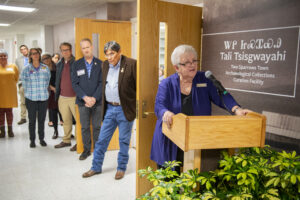Translation by EBCI BELOVED WOMAN MYRTLE DRIVER
By SCOTT MCKIE B.P./One Feather Staff
Note: This article was published in the Cherokee One Feather in March 2019. It has been translated into the Cherokee syllabary here by EBCI Beloved Woman Myrtle Driver, a fluent Cherokee speaker, to aid in language learning.
Translation of Headline: ᏭᏕᎵᎬ ᎦᏯᎴᎾ ᎦᎸᎳᏗᎨ ᏧᎾᏕᎶᏆᏍᏗ ᎤᏂᎦᏔᎲᏍᎩ ᎢᏳᏍᏗ ᎧᏃᎮᏍᎬ ᎦᏙ ᎭᏫᏂᏣ ᎤᎾᏓᏥᏍᎬᎢ ᎡᏘᏴ ᎤᎾᏕᏅ ᎠᏂᏣᎳᎩ ᏣᎳᎩ ᏓᏛᏃᎢ.
Western Carolina University has garnered approval from Tribal Council and the Cherokee Speakers group to name the newly re-opened archaeological collections curation facility the Tali Tsisgwayahi Archaeological (Two Sparrows Town) Collections. The name reflects the original name of the area in the Cherokee language.
ᎧᎸᎬ ᎠᏂᏣᎳᎩ ᎤᎾᏓᏥᏍᎬᎢ ᏗᏂᎳᏫᎩ ᏃᎴ ᏣᎳᎩ ᎠᏂᏬᏂᏍᎩ ᎤᎾᏓᏥᏍᎬᎢ ᎤᏂᎫᏍᏛᏁᎢ ᏭᏕᎵᎬ ᎦᏯᎴᎾ ᎦᎸᎳᏗᎨ ᏧᎾᏕᎶᏆᏍᏗ ᏧᏃᏍᏗ ᎩᎳ ᎤᏂᏍᏚᎩᏓ ᎦᏙ ᎭᏫᏂᏣ ᎤᏂᏓᏍᎩᏌᏅ ᎧᏃᎮᏍᎩ ᎢᏳᏍᏗ ᏄᎵᏍᏔᏂᏙᎸ ᎡᏘᏴ ᏥᎨᏎ ᏃᎴ ᏄᎾᏛᏁᎵᏙᎸ ᎠᏂᏣᎳᎩ ᎭᎾᎾ ᎡᏁᎯ ᎾᎯᏳ ᏥᎨᏎᎢ. ᏔᎵ ᏥᏍᏆᏯᎯ ᏚᏙᎡ ᎾᎯᏳ ᎠᏂᏣᎳᎩ ᏣᏁᎮᎢ.

Former Principal Chief Joyce Dugan, at podium, speaks during the opening of the Tali Tsisgwayahi Archaeological (Two Sparrows Town) Collections in December 2019. (Photos by Ashley Evans/WCU)
Tribal Council approved unanimously Res. No. 524 (2019), during its regular session on Thursday, March 14, that states, “…WCU now assumes responsibility as the official repository for United States Forest Service-owned collections of materials associated with the Cherokee Trail of Tears”. The legislation was submitted by Sky N. Sampson, WCU Cherokee Center director; Bo Lossiah, Kituwah Preservation and Education Program; Dr. Brett Riggs, WCU Sequoyah Distinguished Professor of Cherokee Studies; and Dr. Sara Snyder Hopkins, WCU Cherokee Language Program director.
ᏂᎦᏓ ᏗᏂᎳᏫᎩ ᎤᏂᎶᎯᏍᏔᏅ ᎠᎫᏍᏛᏗ ᎯᏍᎩᏍᎪ-ᏔᎵᏍᎪ-ᏅᎩ (ᏔᎵ-ᎢᏯᎦᏴᎵ-ᏐᏁᎳᏚ) ᏓᏂᎳᏫᎬ ᎠᏅᏱ ᏂᎦᏚᏏᏁᎢ, ᎯᎠ ᏂᎦᏪᎠ”…ᏭᏕᎵᎬ ᎦᏯᎴᎾ ᎦᎸᎳᏗᎨ ᏧᎾᏕᎶᏆᏍᏗ ᏃᏉ ᎠᏃᎯᏳᎲᏍᎦ ᏧᏂᏍᏆᏂᎪᏙᏗ ᎠᎹᏰᎵ ᎠᏂᏩᏥᏂ ᎢᎾᎨᎢ ᏧᎾᎦᏎᏍᏗᏕᎩ ᏚᏂᏍᏆᏂᎪᏛ ᏧᏓᎴᏅᏓ ᎤᏂᏩᏛᏓ ᎤᏂᎶᏒᎢ ᎠᏂᏣᎳᎩ ᏥᎨᎬᏬᎥᏗᏍᎨᎢ. ᎦᎸᎶᎢ ᏌᎻᏏᏂ. ᏭᏕᎵᎬ ᎦᏯᎴᎾ ᎦᎸᎳᏗᎨ ᏧᎾᏙᎴᏆᏍᏗ, ᏍᎦᏰᎬᏍᏓ, ᎡᎳᏬᏗ ᏧᏂᎷᏫᏍᏓᏁᎯ; ᎦᎵᏣᏗ ᏓᎦᎶᏏ, ᎩᏚᏬᎢ ᏧᎾᏕᎶᏆᏍᏗ, ᎣᎦᎾ, ᏭᏕᎵᎬ ᎦᏯᎴᎾ ᎦᎸᎳᏗᎨ ᏧᎾᏕᎶᏆᏍᏗ ᏗᏕᏲᎲᏍᏗ ᏃᎴ ᏎᎳ ᎧᏅᏂᏍᎩ ᏣᎳᎩ ᏧᎾᏕᎶᏆᏍᏗ ᏍᎦᏰᎬᏍᏓ.
Dr. Riggs said during Thursday’s discussion on the resolution, “We wanted to do this in order to keep the Cherokee identity and the identity of that particular place in mind of everyone on campus, and we think that this will be a lasting reminder. We will then compel faculty and staff to learn how to say the name itself in proper Cherokee.”
ᎯᎠᏃ ᏄᏪᏒ ᎣᎦᎾ ᏣᏂᏃᎮᏍᎬ ᎠᎫᏍᏛᏗ, ᎣᎦᏚᎵ ᎬᏂᎨᏒ ᎢᏲᎬᏁᏗ ᏄᎾᏛᏁᎵᏙᎸ ᎠᏂᏣᎳᎩ ᎭᎾᎾ ᏣᏁᎮᎢ ᏃᎴ ᏄᎵᏍᎨᏗᏴ ᎭᎾᏂ, ᎣᏤᎵᎠ ᎢᎪᎯᏓ ᎤᎾᏅᏖᏍᏗ ᏗᎾᏙᎴᏆᏍᎩ ᏃᎴ ᎭᎾ ᏧᏂᎷᏫᏍᏓᏁᎯ. ᏓᏲᏣᏁᎸᏔᏂ ᏦᏤᏲᏗ ᏥᏳᎪᏗ ᎢᏳᏂᏪᏍᏗ ᏚᏙᎥ ᏣᎳᎩ ᎬᏗ.
The resolution gives a summary of the historical significance of the name and area, “In 1826, Cherokee Assistant Principal Chief, Charles R. Hicks, wrote a series of letters to future Chief John Ross to educate him on traditional history and prepare him for leadership roles. In these letters, Hicks relates a migration story from the 1770s that concludes with Cherokees settling at a place called Two Sparrows (Tali Tsisgwayahi), near the head of the Tuckasegee River. Another elder, who gave testimony in the 1830s, identifies Two Sparrows as a holy place, where the surrounding hills were supposed to contain large villages of immortals.”
ᎠᎫᏍᏛᏗ ᎧᏃᎮᎭ ᏄᎵᏍᎨᏗᏴ ᏚᏙᎥ ᎭᎾᏂ. “ᏐᏉ-ᎢᏯᎦᏴᎵ-ᏁᎵᏍᏆ-ᏔᎵᏍᎪ ᏑᏓᎵ ᎤᏕᏘᏴᏌᏗᏒ, ᏔᎵᏁ ᎠᏓᎴᏁ ᎤᎬᏫᏳᎯ ᏣᎵ ᏗᎶᏕᏍᎩ ᏚᏬᏪᎳᏁᎴ ᏗᎪᏪᎵ ᎤᎬᏫᏳᎯ ᎢᎦᎵᏍᏗᏍᏗ ᏣᏂ ᎫᏫᏍᎫᏫ ᏄᎵᏍᏔᏂᏙᎸ ᎭᎾᏂ ᏃᎴ ᎠᎦᏛᏅᎢᏍᏗᏍᎬ ᎤᎬᏫᏳ ᎢᏳᎵᏍᏙᏗᎯ. ᎠᏥᏃᎯᏎᎴ ᏐᏉ-ᎢᏯᎦᏴᎵ-ᎦᎵᏍᏆᏍᎪ-ᎦᎵᏍᏆᏍᎪ ᎤᏕᏘᏴᏌᏗᏒ ᎤᏂᎷᏨ ᎠᏂᏣᎳᎩ ᎭᎾᎾ ᏥᏍᏆᏯᎯ, ᏓᎦᏏᏱ ᎨᏴᎢ ᎾᎥᏂ.
ᏐᏉ-ᎢᏯᎦᏴᎵ-ᏁᎵᏍᎪ-ᏦᏍᎪᎯ ᎤᏕᏘᏴᏌᏗᏒ ᏄᏓᎴ ᎠᎦᏴᎵ ᎤᏃᎮᎴ, ᏔᎵ ᏥᏍᏆᏯ ᎤᎵᏍᎨᏓ ᎦᏚᎲ ᎦᎸᏉᏗ ᎨᏎᎢ. ᎾᎥᏂ ᏚᏕᏯᏍᏛ ᏚᏬᏓᏢ ᏕᎦᏚᎮ ᎠᏁᎲ ᎠᏂᏲᎲᏍᎩ ᏂᎨᏒᎾ.
It went on to state, “In 1887, Smithsonian ethnographer James Mooney recorded Cherokee sources who referred to the mound and ancient town site on what is now WCU’s central campus as Tsisksitsi, meaning ‘a place typified by sparrows’. Mooney’s Tsisk(waya)sitsi (where the sparrows are, in a typical fashion) and Hicks’ Tali Tsisgwayahi (Two Sparrows Place) appear to be the same and designate the place that Western Carolina University is now located.”
ᏁᎳᏚᏁᎵᏍᎪ-ᎦᎵᏉᎩ ᎤᏕᏘᏴᏌᏗᏒ ᏥᎻ ᏅᏓ ᎤᏒᎯ ᎡᎯ ᎠᏥᏃᎯᏎᎴ ᎦᏓ ᎦᏥᏍᎬᎢ ᏃᎴ ᎤᏪᏘ ᎦᏚᎲᎢ, ᎭᎾᎾ ᏭᏕᎵᎬ ᎦᏯᎴᎾ ᎦᎸᎳᏗᎨ ᏧᎾᏙᎴᏆᏍᏗ ᏃᏉ. ᏅᏓ ᎤᏒᎯ ᎡᎯ ᏄᏓᎴ ᏂᎦᏪᏍᎨ ᏚᏙᎥ ᎭᎾᎾ. ᏧᏳᎪᏗ ᎢᎦᏪᏍᏗ ᏔᎵ ᏥᏍᏆᏯᎯ.
Principal Chief Richard G. Sneed thanked those responsible for bringing the resolution forward and said, “I think it is imperative that everyone in the community is aware of the relationship that we have with Western Carolina University. It is very unique in that the university, probably unlike any other organization in the region, is very mindful of the fact that the property on which they reside was a Cherokee town and that there was a mound there.”
ᎤᎬᏫᏳᎯ ᎤᏪᎾᎢ ᏗᎦᏘᏱ ᏚᎵᎮᎴᏤᎸ ᎤᏂᏒᏅ ᎠᎫᏍᏛᏗ. ᎤᎵᏍᎨᏗ ᎨᎵᎠ ᏂᎦᏓ ᎠᏁᎯ ᏆᎸᏱ ᎢᎬᎾᏕᎾ ᎤᎾᏕᎶᎰᎯᏍᏗ ᏙᏣᏓᏍᏕᎵᏍᎬ ᏭᏕᎵᎬ ᎦᏯᎴᎾ ᎦᎸᎳᏗᎨ ᏧᎾᏕᎶᏆᏍᏗ. ᏃᎴ ᎠᏂᎦᏔ ᎠᏂᏣᎳᎩ ᎤᎾᏕᏅ ᎭᎾᎾ ᏃᎴ ᎦᏓ ᎦᏥᏍᎬᎢ ᎭᎾ.
He added, “I’m just very grateful to the Board of Trustees, to the Chancellor, to Dr. Riggs and his staff for honoring and recognizing the Eastern Band of Cherokee Indians and the history of the land on which they reside.”
ᏃᎴᏍᏉ ᎦᏥᏯᎵᎡᎵᏤ ᎤᎾᎦᏎᏍᏗᏕᎩ ᎨᎩᎸᏉᏔᏅᎢ ᎢᏗᏣᎳᎩ ᏃᎴ ᏄᎵᏍᏔᏂᏙᎸ ᎡᏘᏴ ᎭᎾᎾ ᏣᏁᎭ.
Following the vote, Big Cove Rep. Perry Shell commented, “I think it’s very important that we name locations and sites in traditional names, Cherokee names. I would like to see more of that on tribal lands because there are several locations that are called something other than what the Cherokee name for it is.”
ᎱᏂᎶᎯᏍᏔᏃᎾ ᎠᎫᏍᏛᏗ, ᎯᎠ ᏄᏪᏒ ᎪᎳᏅᏱ ᏗᎦᎳᏫᏤᎯ ᎹᎶᏂ ᎤᏯᏍᎦ, “ᎨᎵᎠ ᎤᎵᏍᎨᏗ ᏱᏗᏙᎠ ᏣᎳᎩ ᎬᏗ ᎡᏘᏴ ᎤᎾᏕᎾ ᎠᏂᏣᎳᎩ. ᎣᏍᏓ ᏯᎩᏰᎸ ᏯᎦᏓ
ᏧᏳᎪᏗ ᏱᏓᏃᎠ ᎠᏂᏣᎳᎩ ᎤᎾᏤᎵᎪ ᏄᎵᏍᏔᏅᎢ.
Three Cherokee fluent speakers and members of the Cherokee Speakers group signed the legislation approving the Cherokee language within including: Beloved Woman Myrtle Driver, Charlie Bigwitch, and Roger Smoker.
ᏦᎢ ᎢᏯᏂ ᏣᎳᎩ ᎠᏂᏬᏂᏍᎩ, ᎥᎭᏴᎵ ᏗᏰᎴᎩ, ᏣᎵ ᏍᎩᎵᎡᏆ ᏃᎴ ᎳᏥ ᏧᎦᏒᏍᏗ ᎤᏂᏍᏓᏱᏛ ᎠᎫᏍᏛᏗ ᎠᏃᎯᏴᏗᏍᎩ ᏣᎳᎩ ᏕᎪᏪᎸᎢ.


